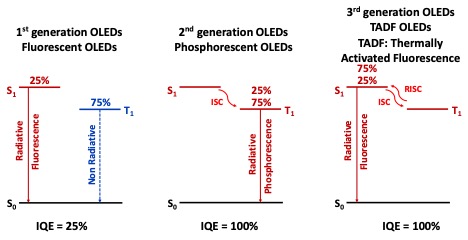
Since the first demonstration of the operation of two-layer organic light emitting diodes (OLEDs), considerable improvements have been made, in particular in the material design. Initial developments were based on fluorescent OLEDs that use the emission of singlet excited states. Much attention has also been paid to the two metal-semiconductor interfaces of OLED devices to improve the injection of holes and electrons, as well as to the optimization of the nature of dye-containing emitter layer (EML) blends. However, the first generation of OLEDs is limited by low internal quantum efficiencies (IQE) of maximum ca.25%, since upon electrical excitation of the device, spin statistics only allow for the formation of 25% of singlet excited states while 75% of the excited states are triplets.
These limitations have been successfully overcome with the second generation of OLEDs that uses phosphorescent materials for the blend of the EML. Phosphorescence is essentially obtained by using heavy metal-based emitters (such as ruthenium, iridium, platinum…) in which the metal induces a strong spin-orbit coupling (SOC) draining quantitatively all singlet excited states to the triplet excited states that are able to emit light. With this technology, an IQE of 100% can be reached. However, due to the shortage and high cost of such metals, this strategy is not viable for large scale developments.
Later on, molecules exhibiting the now well-known delayed fluorescence were introduced into devices. In this process, the triplet excited states inherently formed electrically are converted into singlet excited states through reverse intersystem crossing (RISC), yielding an IQE of 100%. For this process (commonly called Thermally Activated Delayed Fluorescence, or TADF), it has been demonstrated that a close proximity of the singlet and triplet excited states (small DES-T, the energy gap between the lowest singlet and triplet excited states) and a large SOC results in an efficient RISC. In the TADF molecules, a small DES-T is obtained by twisting the donor group from the acceptor group resulting in a small electron exchange energy (KHL) which is directly related to the energy gap between the lowest singlet and triplet excited states (DES-T = 2 KHL). In order to optimize the SOC, the singlet and triplet excited states involved in the RISC have to be defined with two different wave-functions. Following this approach, a large number of dyes (spanning from the blue to the red) have been designed and show efficient OLED’s operating properties.
Only recently, multi-resonance (MR) and vibrations induced SOC-TADF dyes have been developed and are subject to an extended amount of research. While in MR TADF, the mechanism is strongly related to the small DES-T, vibrations induced SOC-TADF are more related to the large value of the spin-orbit coupling and therefore to the control of the nature of the singlet and triplet excited states.
Within StelOrg, different research teams are interested in the design, synthesis and the study of photophysical properties of the EML layer following different strategies, as described thereafter.